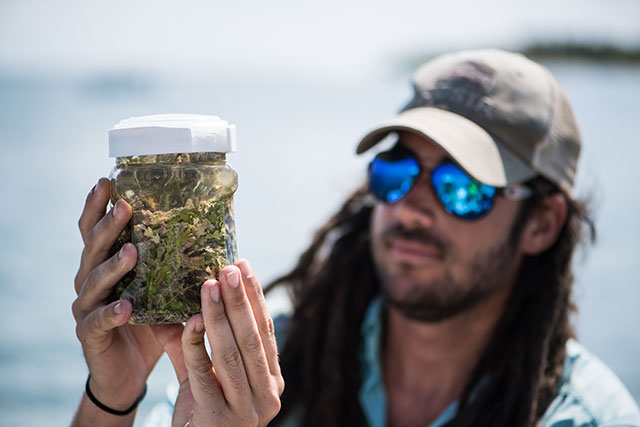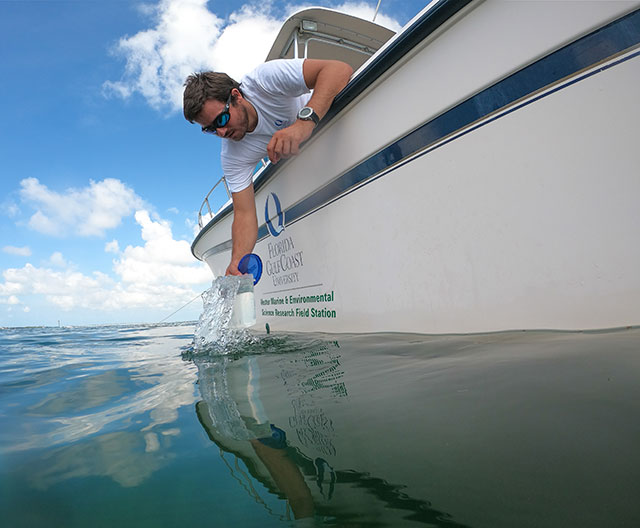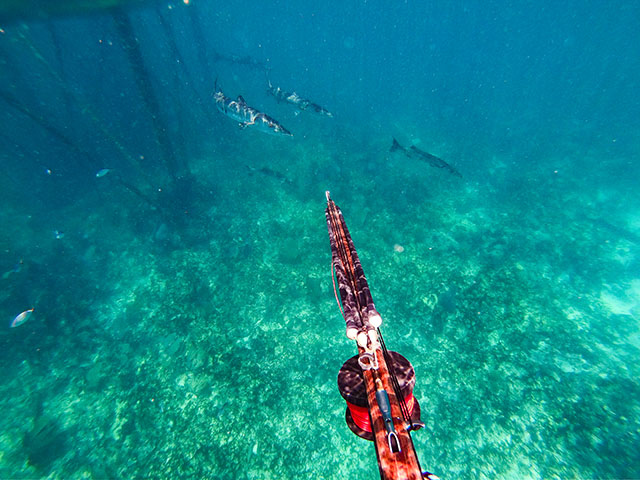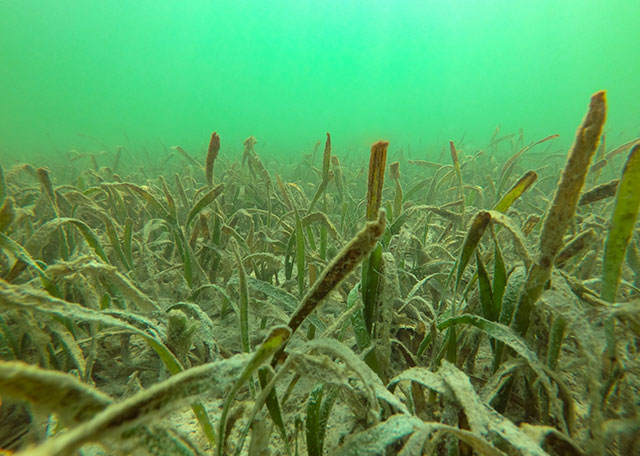The divers are pursuing Gambierdiscus silvae, a single-celled microalgae that causes ciguatera fish poisoning. It’s not as well-known as other harmful algae like the one behind red tide, but ciguatoxin is the main source of seafood illness that’s not caused by product spoilage.

“We want to gather it to do cultures and keep it alive back at the lab so we can see what conditions make it thrive,” explains FGCU alum Adam Catasus (’15, Marine Science; ’17 Environmental Science Master’s), who stays aboard the FGCU’s 27-foot Grady White, scribbling notes on weather and water conditions, while the divers gather samples about 7 feet below the surface. “It’s very temperamental. It only grows in a 3-4 degree temperature range and in low concentrations — very low and slow.”
Once the bug and its range are better understood through this five-year, grant-funded study, the plan is to develop a warning system for fishers and consumers to avoid harvesting and eating seafood from affected areas.
This isn’t FGCU’s first foray into ciguatera poisoning, which affects people all over the world who eat fish. FGCU marine science professor Michael Parsons, the principal investigator on this $5.9 million project, previously led a five-year, $4 million NOAA-funded study on the toxin causing fish poisoning. In fact, that project led to the discovery of the “superbug” that has steered Parsons’ research in a new direction.
“Our efforts now are a really zeroing in on this particular species of Gambierdiscus,” Parsons says. “It’s a thousand times more toxic than other Gambierdiscus species. We’re learning more about when the superbug is out there, under what conditions, when to expect the most toxic load on reefs and how to better predict when the toxin is moving into fish. Ultimately, we want to be able to safeguard people against eating the toxic fish.”

To achieve that result, Parsons and his team first have to address a number of questions: What sustains the toxic algae? How is its development affected by coral reef health, warming sea temperatures and disturbances like hurricanes? Do crabs and other invertebrates ingest the toxin while munching on seagrass? And which fish higher on the food chain, like grouper and hogfish, in turn consume those tainted critters?
“It’s really hard to measure toxins,” Parsons says. “We’re collecting samples so we have a baseline to measure how other these other factors change toxin levels. It looks like when ciguatera events occur it’s not really a bloom like red tide or blue-green algae.”
![]() Traveling down to the Middle Keys every three months to take samples at the same seven sites helps the team document how seasonal changes affect Gambierdiscus silvae. In July, research scientist Catasus was accompanied by alums Nick Culligan (’18, Environmental Science Master’s) and Ashley Brandt (’12, Environmental Studies & Marine Science; ’16, Environmental Science Master’s); and graduate students Katie Ribble (’15, Marine Science) and Andrea James (’19, Environmental Science Master’s).
Traveling down to the Middle Keys every three months to take samples at the same seven sites helps the team document how seasonal changes affect Gambierdiscus silvae. In July, research scientist Catasus was accompanied by alums Nick Culligan (’18, Environmental Science Master’s) and Ashley Brandt (’12, Environmental Studies & Marine Science; ’16, Environmental Science Master’s); and graduate students Katie Ribble (’15, Marine Science) and Andrea James (’19, Environmental Science Master’s).
[vc_video link=”https://youtu.be/8TO291ksso4″ align=”center” padding=”0″”]
[ Learn more about degree programs in The Water School at FGCU ]
They emerge from their dive off Lower Matecumbe with containers of water and emerald-green turtle grass coated with oatmeal-like clumps of epiphytes, another kind of algae, which thrive in summer’s warmer waters. After they boat back to the Keys Marine Lab on Long Key at the end of the day, the team will sift their samples through multiple filters and end up with a sediment that resembles a Frosty from Wendy’s. Specimens are later examined in labs and tested for toxins that cause ciguatera poisoning.

When they’re finished diving off Matecumbe, the team pulls anchor and motors south under a causeway bridge to reach the Tennessee Reef southeast of Long Key, a part of the Florida Reef with an area open only for researchers. The teal-green water runs about 25 feet deep where they dive, somewhat less successfully than earlier in the morning.
“We don’t usually have trouble getting samples, but the current’s strong today and I could feel myself moving with it,” Andrea James says while peeling off her scuba gear back onboard. “There’s a lot of fish down there, but I had my nose in the sand. I’m so focused on getting the algae I need that I wouldn’t know if a shark came up behind me.”
The team decides to shift focus to spear-fishing near the historic Tennessee Reef light tower. Originally built in 1933, the 49-foot skeletal structure is currently providing refuge for a convoy of frigatebirds resting their expansive wings. The superbug has been documented around here, too, and the porkfish and barracuda they reap today will offer clues to its impact. Like many marine toxins, ciguatoxins biomagnify — they become more concentrated in the fish tissue as the toxin moves up the food web. In general, the larger fish that eat the smaller reef fish store higher levels of the toxin, and therefore are more likely to pass on ciguatera to people.

“Barracuda are at the top of the food chain,” Catasus says, after carefully extricating a toothy 3 1/2-footer from a spear. “They usually have a high likelihood of being toxic from eating smaller fish.”
While barracuda aren’t commonly eaten in the United States, sometimes fish are misidentified or mislabeled, Catasus explains, and end up in markets or restaurants unknowingly. In the past, ciguatera was primarily a concern in tropical and subtropical areas, but fish from those waters are exported to markets across the globe, making the illness a worldwide concern.
“People get exposed to ciguatera a lot in the Caribbean,” Catasus says. “Over 15-20 years, what are the effects? It’s a neurotoxin, and we have no data on long-term exposure.”
The work they’re doing today, the sampling and the processing, is just a small step toward compiling data that will help scientists, fishers and consumers better understand ciguatera poisoning. Back at the FGCU campus, they will do tissue extractions on the fish speared today that will be sent elsewhere for analysis. Algae samples will undergo several time-consuming processes as single cells are isolated and grown in a campus lab.

Parsons’ latest research is funded by the National Science Foundation and the National Institute of Environmental Health Sciences, part of the National Institutes of Health. The grant funds the Greater Caribbean Center for Ciguatera Research at FGCU, which also involves researchers from the University of South Alabama, Mitchell Cancer Institute, Dauphin Island Sea Lab, University of Texas Marine Science Institute, Woods Hole Oceanographic Institute and the University of the Virgin Islands.
Parsons, director of FGCU’s Vester Marine and Environmental Science Research Field Station, hopes the five-year project will help him create forecasting abilities that can guide the fishing industry to avoid harvesting fish that are likely infected. Ciguatoxins are heat-stable, meaning they remain dangerous even after the fish has been cooked. An estimated 50,000 people around the world become sick with ciguatera fish poisoning each year.
“We have a working model right now, and the next step would be to use it to say there is a greater chance of getting ciguatera if you eat fish caught in this location,” Parsons says. “We have to partner with the local fishery managers and commercial fishers on how to work with those advisories.”[/vc_column_text][vc_column_text]
What it is:
Ciguatera fish poisoning comes from a microalga called Gambierdiscus silvae.
Where it’s found:
In fish such as hogfish, barracuda, snapper, grouper and other species eaten by people. However, the toxin isn’t always present.
Signs of Sickness:
More than 50,000 people a year contract ciguatera fish poisoning from eating hogfish, barracuda, snapper, grouper and other species carrying the toxin. Symptom include abdominal cramps, diarrhea, nausea, vomiting, headaches, muscle aches and numbness. Some victims experience strange sensations, like loose teeth, intense itching or confusion between hot and cold temperatures. The illness can last weeks or linger for years.[/vc_column_text]